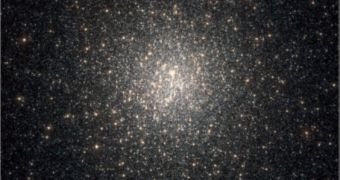Globular clusters (globulus is Latin for small sphere)have been considered fully explained until recently, when new observations by NASA's Hubble Space Telescope showed intriguing images that changed the classical perception of this massive star agglomerates.
Astronomers have assumed that globular star cluster had a single stage of stars formation, called "baby boom", early in their lives and then moved on with a quiet existence.
The globular cluster is a spherical collection of stars that orbits a galactic core much like a satellite. Due to the fact that they are very tightly bound by gravity, they have spherical shapes and relatively high stellar densities toward their centers. Found in the halo of a galaxy, they contain considerably more stars and are much older than the less dense galactic, or open clusters, which are found in the disk.
A new analysis of the massive globular cluster NGC 2808, made by Hubble telescope, provided evidence that star birth had three generations of stars forming very early in the cluster's life, a surprising triple "baby boom" at relatively small intervals.
"We had never imagined that anything like this could happen," said Giampaolo Piotto of the University of Padova in Italy and leader of the team that made the discovery. "This is a complete shock."
At the moment, there are about 150 currently known globular clusters in the Milky Way, with perhaps 10 to 20 more undiscovered. Larger galaxies can have more: Andromeda, for instance, may have as many as 500. Some giant elliptical galaxies, such as M87, may have as many as 10,000 globular clusters.
"The standard picture of a globular cluster is that all of its stars formed at the same time, in the same place, and from the same material, and they have co-evolved for billions of years," said team member Luigi Bedin of the European Space Agency, the European Organization for Astronomical Research in the Southern Hemisphere (ESO), in Garching, Germany, and the Space Telescope Science Institute in Baltimore, Md. "This is the cornerstone on which much of the study of stellar populations has been built. So we were very surprised to find several distinct populations of stars in NGC 2808. All of the stars were born within 200 million years very early in the life of the 12.5-billion-year-old massive cluster."
They measured the color and brightness of the cluster stars in NCG 2808, and with the help of the considerable resolution that this instrument offered, they sorted out the different stellar populations. The Hubble measurements showed three distinct populations, with each successive generation appearing slightly bluer. This color difference suggests that successive generations contain a slightly different mix of some chemical elements.
"One assumption, although we have no direct proof," said team member Ivan King of the University of Washington in Seattle, "is that the successively bluer color of the stellar populations indicates that the amount of helium increases with each generation of stars. Perhaps massive star clusters like NGC 2808 hold onto enough gas to ignite a rapid succession of stars." The forming mechanism has been theorized by King, who said that the birth of the stars is caused by shock waves from supernovae and stellar winds from giant stars, which compress the gas and make new stars.
"We need to do our best to solve the enigma of these multiple generations of stars found in these Hubble observations so that we can understand how stars formed in distant galaxies in our early universe," concluded Giampaolo Piotto.

 14 DAY TRIAL //
14 DAY TRIAL //